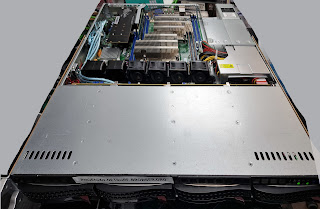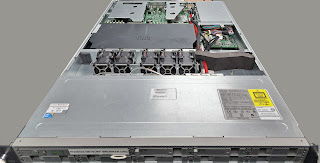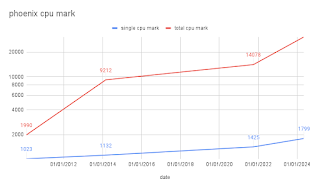I like the sentiment of Helen Hunt Jackson in that quote and it generally applies double for computer system names. However I like to think when I named the first NetSurf VM host server phoenix fourteen years ago I captured the nature of its continuous cycle of replacement.
We have been very fortunate to receive a donated server to replace the previous every few years and the very generous folks at Collabora continue to provide hosting for it.Recently I replaced the server for the third time. We once again were given a replacement by Huw Jones in the form of a SuperServer 6017R-TDAF system with dual Intel Xeon Ivy Bridge E5-2680v2 processors. There were even rack rails!The project bought some NVMe drives and an adaptor cards and I attempted to arrange to swap out the server in January.
Here we come to the slight disadvantage of an informal arrangement where access to the system depends upon a busy third party. Unfortunately it took until May to arrange access (I must thank Vivek again for coming in on a Saturday to do this)
In the intervening time, once I realised access was going to become increasingly difficult, I decided to obtain as good a system as I could manage to reduce requirements for future access.
I turned to eBay and acquired a slightly more modern SuperServer with dual Intel Xeon Haswell E5-2680v3 processors which required purchase of 64G of new memory (Haswell is a DDR4 platform).
I had wanted to use Broadwell processors but this exceeded my budget and would only be a 10% performance uplift (The chassis, motherboard and memory cost £180 and another £50 for processors was just too much, maybe next time)
While making the decision on the processor selection I made a quick chart of previous processing capabilities (based on a passmark comparison) of phoenix servers and was startled to discover I needed a logarithmic vertical axis. Multi core performance of processors has improved at a startling rate in the last decade.
When the original replacement was donated I checked where the performance was limited and noticed it was mainly in disc access which is what prompted the upgrade to NVMe (2 gigabytes a second peek read throughput) which moved the bottleneck to the processors where, even with the upgrades, it remains.
I do not really know if there is a conclusion here beyond noting NetSurf is very fortunate as a project to have some generous benefactors both for donating hardware and hosting for which I know all the developers are grateful.
Now I just need to go and migrate a huge bunch of virtual machines and associated sysadmin to make use of these generous donations.



https://techgination.com/ very good
ReplyDeleteNice Note Please visit the Website (https://valuefocussed.com/)
ReplyDeleteYour writing style makes even technical topics enjoyable to read—great work! Reolume
ReplyDeleteI appreciate the practical tips and actionable advice you provided.
ReplyDeleteNitro PDF Pro
I really enjoyed reading about the evolution of the Phoenix server, Vincent! It’s impressive to see how the technology has progressed over the years, especially with the increase in multi-core performance. It’s also great to see such a strong community of supporters and contributors, from hardware donations to hosting. Your efforts in keeping NetSurf running smoothly are truly inspiring! Keep up the amazing work, and best of luck with the migration process! If You want to see cookout menu with prices then visit this link https://thecookoutmenus.com
ReplyDeleteEach to their calling’—a gentle yet powerful reminder that everyone moves toward what speaks to their nature. Thank you for this quiet wisdom. Turbo Photoline
ReplyDeleteIt’s fascinating to read about the continuous evolution of your server setup and the thought behind naming your systems! Managing hardware upgrades with such care really shows dedication. While taking a break from tech tasks, anyone might also enjoy some delicious food—check out the cookout restaurant menu for tasty options to keep your energy up during long projects.
ReplyDelete